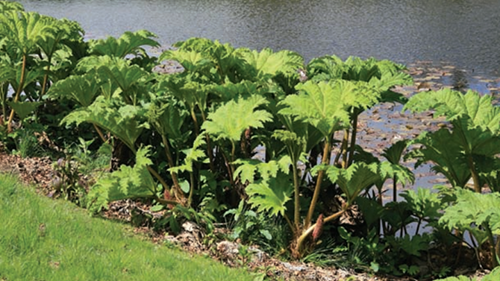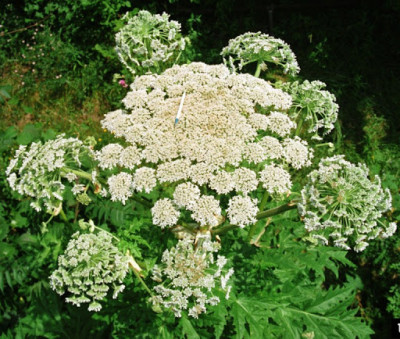Giant gunnera, both native to South America, were introduced to New Zealand as ornamental plants. They are large clump-forming, summer green herbs (they die back in winter). Where they have spread into natural areas, they can exclude almost all other plants where they grow. Both species have stout rhizomes (large fleshy underground stems) and massive umbrella-sized leaves (to one metre wide). They look a lot like a giant version of a rhubarb plant.
Giant gunnera grows vigorously during spring and early summer, forming new stems, leaves and flower spikes which grow from the base of the leaves. Giant gunnera can establish on damp coastal bluffs, wet cliffs, the riparian margins of waterways and wetlands, and in disturbed areas.

What does it look like?
Both species are very similar although Gunnera manicata grows taller, to 3m high while Gunnera tinctoria usually reaches 2m in height. Gunnera tinctoria has spread from cultivation into natural areas, while G. manicata produces seedlings less frequently in the wild.
Flowers
- Cone-shaped flower spikes produced in summer, growing up to 1m tall.
- Each spike is covered with tiny red-green flowers.
- Flowers from spring to early summer.
Fruit/seeds
- Produces abundant tiny round fruit (orange in tinctoria, orange-red in G. manicata).
- Fruit are eaten and spread by birds.
- Each spike can produce up to 80,000 seeds.
Leaves/stems
- The large leaves have 5-9 lobes and are hairy beneath, especially along the leaf veins.
- tinctoria leaves are up to 1m across while G. manicata leaves can be up to 2m across.
- Leaves and stems are covered in rubbery prickles.
Similar plants
Giant hogweed (Heracleum mantegazzianum) looks similar to (but should not be confused with) giant gunnera. Giant hogweed’s leaves are more deeply lobed. It has tall flower stalks with large umbrella-like clusters of greenish-white flowers.

Why is it a pest?
Giant gunnera has now moved from the garden into the wild. It grows into large plants with very big leaves, forming dense patches that can shade out and suppress native vegetation and exclude virtually all other plants.
Both species produce an abundance of viable seed (approximately 250,000 seeds in a year), which are bird dispersed. They can also spread by rapid rhizome growth, making them difficult to control. Giant gunnera threatens the integrity of indigenous communities, alters the habitats of birds, insects and lizards, can block drains and streams, obstruct access to natural and recreational areas, and contribute to erosion on slip-prone banks.
In the Taranaki region, giant gunnera has aggressively invaded a number of areas, including bluffs, wet cliffs and along several waterways. In the Waikato, giant gunnera is beginning to exhibit the same pattern of spread and establishment. Acting now to control it will help us to avoid similar spread and impacts in our region.
Control methods
Do not attempt to control giant gunnera yourself.
Waikato Regional Council is responsible for controlling giant gunnera and it is illegal for anyone else to disturb or remove giant gunnera plants.
More information
Advice
- For additional information and advice on giant gunnera, call our pest plant staff on freephone 0800 800 401.
Publications
- The following publications are available for download or from Waikato Regional Council. Contact us to request a copy (freephone 0800 800 401).






